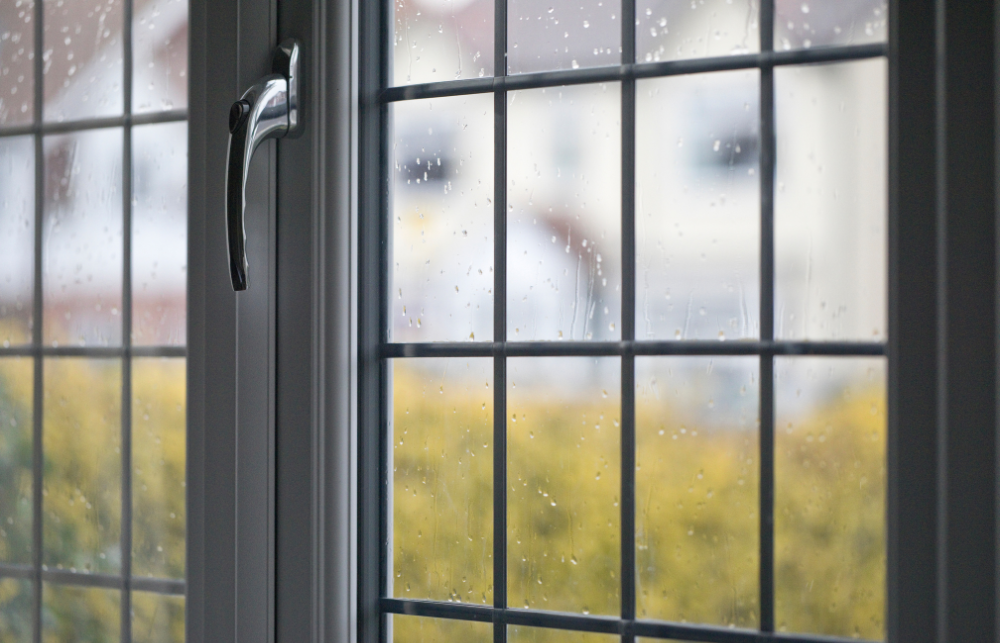Common Mistakes to Avoid When Painting uPVC Windows & Doors

We’ve sold thousands of uPVC paints and have seen some amazing results. On the other hand, unfortunately we have seen some paint jobs go awry due to avoidable errors.
If you’re painting your uPVC windows or doors, watch out for these common mistakes.
Painting in adverse weather conditions
To achieve a perfect finish, it’s critically important to only paint in suitable weather conditions.
Avoid the rain: Painting external doors and windows on a rainy day is, of course, a bad idea. Direct rain on the surface will inhibit proper adhesion to the surface, prevent the paint from drying and lead to a streaky finish.
Watch out for humidity: It needs to be a dry day, not damp. Even when it’s not raining, high humidity in the air introduces too much moisture to the paint, which can lead to a mildew, condensation or even ‘gunky’ effect. Using an aerosol or spray gun application method can be particularly problematic in high humidity.Drying times will be affected too, so when painting outdoors it’s best to paint on days with a maximum humidity level of 80% and no risk of rain.
Dodge extreme temperatures: Painting when it’s either too hot or too cold can cause paint to dry too quickly or too slowly, affecting adhesion and finish quality. The ideal air temperature when painting uPVC is between 10°C and 25°C. Be mindful of the surface temperature of the uPVC too – direct sunlight can heat up the plastic which again can have a negative impact on application, adhesion and finish. It’s advisable to paint outside of direct sunlight and avoid midday heat on hot summer days. On the other hand, freezing temperatures can wreak havoc with some paints – we recommend a minimum surface temperature of 5°C when using PaintNuts uPVC paints.
Beware windy days: Dust and dirt can contaminate paint until the point at which it becomes ‘dust dry’. For this reason, PaintNuts uPVC paint has ultra-fast drying times. Ensure your uPVC paint is quick drying, otherwise dust particles in the air could spoil your efforts.
Poor preparation
The old adage of ‘fail to prepare, prepare to fail’ holds true here. Follow these simple steps to avoid any ‘shudda cudda wudda’ post-project regrets.
Ensure the uPVC is clean and free from any dust or dirt. Use degreaser to effectively remove stubborn contaminants, grease or wax. You then need to ‘key’ the surface – this is essentially a light sanding to remove the top-level sheen from the uPVC by gently rubbing with a light grit scotch cloth or fine sand paper. Don’t skip this step. Keying the surface will improve adhesion and ensure a longer-lasting finish. Wipe down again with degreaser to remove any residue. Mask around the target area to make sure the paint only goes where you want it.
PaintNuts uPVC paint doesn’t require a primer but you should check whether this is the case with your paint. Follow the manufacturer’s instructions and don’t skip the prep!
Failure to fully mix the paint
Save yourself a headache and be sure to properly mix your paint before use. When left to sit, paint separates and settles into layers. Regardless of whether it’s a tin of paint, an aerosol can or even a small tester pot, be sure to thoroughly mix the paint prior to application.

Using the wrong paint
Use a specialist uPVC paint. We’re biased and of course we recommend our own PaintNuts uPVC Window & Door paint. Regardless of which brand you go with, ensure the paint is specifically made for use with uPVC. uPVC paint should be quick drying, weatherproof and UV resistant.
Choosing the wrong colour
uPVC paint is available in almost any colour you can imagine. You’re not limited to what’s on the shelf in your local paint store. Whether it’s the highly popular Anthracite Grey, a stylish Jet Black or a bold statement colour such as Colza Yellow or Pure Orange – feel free to stamp your style on your property. Whatever colour you choose, test the paint in a discreet location to ensure you’re fully confident before diving into a full paint job.
-
 PaintNuts uPVC Paint - Steel BlueSelect product to see price £14.99
PaintNuts uPVC Paint - Steel BlueSelect product to see price £14.99 -
 PaintNuts uPVC Paint - Ruby RedSelect product to see price £14.99
PaintNuts uPVC Paint - Ruby RedSelect product to see price £14.99 -
 PaintNuts uPVC Paint - Anthracite GreySelect product to see price £14.99
PaintNuts uPVC Paint - Anthracite GreySelect product to see price £14.99 -
 PaintNuts uPVC Paint - Fir GreenSelect product to see price £14.99
PaintNuts uPVC Paint - Fir GreenSelect product to see price £14.99 -
 PaintNuts uPVC Paint - Agate GreySelect product to see price £14.99
PaintNuts uPVC Paint - Agate GreySelect product to see price £14.99








